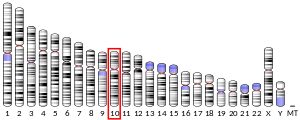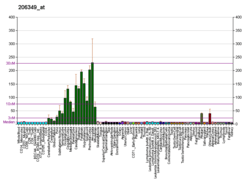LGI1
Leucine-rich, glioma inactivated 1, also known as LGI1, is a protein which in humans is encoded by the LGI1 gene.[4] It may be a metastasis suppressor.
Function
The leucine-rich glioma inactivated -1 gene is rearranged as a result of translocations in glioblastoma cell lines. The protein contains a hydrophobic segment representing a putative transmembrane domain with the amino terminus located outside the cell. It also contains leucine-rich repeats with conserved cysteine-rich flanking sequences. This gene is predominantly expressed in neural tissues and its expression is reduced in low grade brain tumors and significantly reduced or absent in malignant gliomas.[4]
Clinical significance
Since its earliest discovery, the LGI1 gene has been implicated in the control of cancer metastasis and in a predisposition to epilepsy. Following genetic linkage studies placing the hereditary form of autosomal dominant partial epilepsy with auditory features (ADPEAF) on chromosome region 10q24[5][6] mutation analysis of affected members in these families[7][8][9] demonstrated LGI1 was a major cause of the disease.
More recently, LGI1 has been shown to be the major target of human autoantibodies[10][11][12] which immunoprecipitate voltage-gated potassium channel complexes from mammalian brain tissue. LGI1 antibodies are found in patients with limbic encephalitis and in patients with faciobrachial dystonic seizures (FBDS). FBDS are a recently described form of epilepsy which is characterized by frequent, brief seizures which affect the arm and face. They appear to be preferentially responsive to immunotherapy over anti-epileptic drugs.
Interactions
LGI1 has been shown to interact with ADAM22,[13] and DLG4.[13]
References
- GRCh38: Ensembl release 89: ENSG00000108231 - Ensembl, May 2017
- "Human PubMed Reference:". National Center for Biotechnology Information, U.S. National Library of Medicine.
- "Mouse PubMed Reference:". National Center for Biotechnology Information, U.S. National Library of Medicine.
- "Entrez Gene: LGI1 leucine-rich, glioma inactivated 1".
- Ottman R, Risch N, Hauser WA, Pedley TA, Lee JH, Barker-Cummings C, Lustenberger A, Nagle KJ, Lee KS, Scheuer ML (May 1995). "Localization of a gene for partial epilepsy to chromosome 10q". Nature Genetics. 10 (1): 56–60. doi:10.1038/ng0595-56. PMC 2823475. PMID 7647791.
- Wilson MH, Puranam RS, Ottman R, Gilliam C, Limbird LE, George AL, McNamara JO (December 1998). "Evaluation of the alpha(2A)-adrenergic receptor gene in a heritable form of temporal lobe epilepsy". Neurology. 51 (6): 1730–1. doi:10.1212/wnl.51.6.1730. PMID 9855534.
- Kalachikov S, Evgrafov O, Ross B, Winawer M, Barker-Cummings C, Martinelli Boneschi F, Choi C, Morozov P, Das K, Teplitskaya E, Yu A, Cayanis E, Penchaszadeh G, Kottmann AH, Pedley TA, Hauser WA, Ottman R, Gilliam TC (March 2002). "Mutations in LGI1 cause autosomal-dominant partial epilepsy with auditory features". Nature Genetics. 30 (3): 335–41. doi:10.1038/ng832. PMC 2606053. PMID 11810107.
- Ottman R, Winawer MR, Kalachikov S, Barker-Cummings C, Gilliam TC, Pedley TA, Hauser WA (April 2004). "LGI1 mutations in autosomal dominant partial epilepsy with auditory features". Neurology. 62 (7): 1120–6. doi:10.1212/01.wnl.0000120098.39231.6e. PMC 1361770. PMID 15079011.
- Nobile C, Michelucci R, Andreazza S, Pasini E, Tosatto SC, Striano P (April 2009). "LGI1 mutations in autosomal dominant and sporadic lateral temporal epilepsy". Human Mutation. 30 (4): 530–6. doi:10.1002/humu.20925. PMID 19191227.
- Irani SR, Stagg CJ, Schott JM, Rosenthal CR, Schneider SA, Pettingill P, Pettingill R, Waters P, Thomas A, Voets NL, Cardoso MJ, Cash DM, Manning EN, Lang B, Smith SJ, Vincent A, Johnson MR (October 2013). "Faciobrachial dystonic seizures: the influence of immunotherapy on seizure control and prevention of cognitive impairment in a broadening phenotype". Brain. 136 (Pt 10): 3151–62. doi:10.1093/brain/awt212. PMID 24014519.
- Irani SR, Michell AW, Lang B, Pettingill P, Waters P, Johnson MR, Schott JM, Armstrong RJ, S Zagami A, Bleasel A, Somerville ER, Smith SM, Vincent A (May 2011). "Faciobrachial dystonic seizures precede Lgi1 antibody limbic encephalitis". Annals of Neurology. 69 (5): 892–900. doi:10.1002/ana.22307. PMID 21416487.
- Irani SR, Alexander S, Waters P, Kleopa KA, Pettingill P, Zuliani L, Peles E, Buckley C, Lang B, Vincent A (September 2010). "Antibodies to Kv1 potassium channel-complex proteins leucine-rich, glioma inactivated 1 protein and contactin-associated protein-2 in limbic encephalitis, Morvan's syndrome and acquired neuromyotonia". Brain. 133 (9): 2734–48. doi:10.1093/brain/awq213. PMC 2929337. PMID 20663977.
- Fukata Y, Adesnik H, Iwanaga T, Bredt DS, Nicoll RA, Fukata M (September 2006). "Epilepsy-related ligand/receptor complex LGI1 and ADAM22 regulate synaptic transmission". Science. 313 (5794): 1792–5. doi:10.1126/science.1129947. PMID 16990550.
Further reading
- Staub E, Pérez-Tur J, Siebert R, Nobile C, Moschonas NK, Deloukas P, Hinzmann B (September 2002). "The novel EPTP repeat defines a superfamily of proteins implicated in epileptic disorders". Trends in Biochemical Sciences. 27 (9): 441–4. doi:10.1016/S0968-0004(02)02163-1. PMID 12217514.
- Gu W, Brodtkorb E, Piepoli T, Finocchiaro G, Steinlein OK (May 2005). "LGI1: a gene involved in epileptogenesis and glioma progression?". Neurogenetics. 6 (2): 59–66. doi:10.1007/s10048-005-0216-5. PMID 15827762.
- Chernova OB, Somerville RP, Cowell JK (December 1998). "A novel gene, LGI1, from 10q24 is rearranged and downregulated in malignant brain tumors". Oncogene. 17 (22): 2873–81. doi:10.1038/sj.onc.1202481. PMID 9879993.
- Morante-Redolat JM, Gorostidi-Pagola A, Piquer-Sirerol S, Sáenz A, Poza JJ, Galán J, Gesk S, Sarafidou T, Mautner VF, Binelli S, Staub E, Hinzmann B, French L, Prud'homme JF, Passarelli D, Scannapieco P, Tassinari CA, Avanzini G, Martí-Massó JF, Kluwe L, Deloukas P, Moschonas NK, Michelucci R, Siebert R, Nobile C, Pérez-Tur J, López de Munain A (May 2002). "Mutations in the LGI1/Epitempin gene on 10q24 cause autosomal dominant lateral temporal epilepsy". Human Molecular Genetics. 11 (9): 1119–28. doi:10.1093/hmg/11.9.1119. PMID 11978770.
- Scheel H, Tomiuk S, Hofmann K (July 2002). "A common protein interaction domain links two recently identified epilepsy genes". Human Molecular Genetics. 11 (15): 1757–62. doi:10.1093/hmg/11.15.1757. PMID 12095917.
- Gu W, Brodtkorb E, Steinlein OK (September 2002). "LGI1 is mutated in familial temporal lobe epilepsy characterized by aphasic seizures". Annals of Neurology. 52 (3): 364–7. doi:10.1002/ana.10280. PMID 12205652.
- Pizzuti A, Flex E, Di Bonaventura C, Dottorini T, Egeo G, Manfredi M, Dallapiccola B, Giallonardo AT (March 2003). "Epilepsy with auditory features: a LGI1 gene mutation suggests a loss-of-function mechanism". Annals of Neurology. 53 (3): 396–9. doi:10.1002/ana.10492. PMID 12601709.
- Fertig E, Lincoln A, Martinuzzi A, Mattson RH, Hisama FM (May 2003). "Novel LGI1 mutation in a family with autosomal dominant partial epilepsy with auditory features". Neurology. 60 (10): 1687–90. doi:10.1212/01.wnl.0000063324.39980.4a. PMID 12771268.
- Kunapuli P, Chitta KS, Cowell JK (June 2003). "Suppression of the cell proliferation and invasion phenotypes in glioma cells by the LGI1 gene". Oncogene. 22 (26): 3985–91. doi:10.1038/sj.onc.1206584. PMID 12821932.
- Clark HF, Gurney AL, Abaya E, Baker K, Baldwin D, Brush J, Chen J, Chow B, Chui C, Crowley C, Currell B, Deuel B, Dowd P, Eaton D, Foster J, Grimaldi C, Gu Q, Hass PE, Heldens S, Huang A, Kim HS, Klimowski L, Jin Y, Johnson S, Lee J, Lewis L, Liao D, Mark M, Robbie E, Sanchez C, Schoenfeld J, Seshagiri S, Simmons L, Singh J, Smith V, Stinson J, Vagts A, Vandlen R, Watanabe C, Wieand D, Woods K, Xie MH, Yansura D, Yi S, Yu G, Yuan J, Zhang M, Zhang Z, Goddard A, Wood WI, Godowski P, Gray A (October 2003). "The secreted protein discovery initiative (SPDI), a large-scale effort to identify novel human secreted and transmembrane proteins: a bioinformatics assessment". Genome Research. 13 (10): 2265–70. doi:10.1101/gr.1293003. PMC 403697. PMID 12975309.
- Hedera P, Abou-Khalil B, Crunk AE, Taylor KA, Haines JL, Sutcliffe JS (March 2004). "Autosomal dominant lateral temporal epilepsy: two families with novel mutations in the LGI1 gene". Epilepsia. 45 (3): 218–22. doi:10.1111/j.0013-9580.2004.47203.x. PMID 15009222.
- Kunapuli P, Kasyapa CS, Hawthorn L, Cowell JK (May 2004). "LGI1, a putative tumor metastasis suppressor gene, controls in vitro invasiveness and expression of matrix metalloproteinases in glioma cells through the ERK1/2 pathway". The Journal of Biological Chemistry. 279 (22): 23151–7. doi:10.1074/jbc.M314192200. PMID 15047712.
- Berkovic SF, Izzillo P, McMahon JM, Harkin LA, McIntosh AM, Phillips HA, Briellmann RS, Wallace RH, Mazarib A, Neufeld MY, Korczyn AD, Scheffer IE, Mulley JC (April 2004). "LGI1 mutations in temporal lobe epilepsies". Neurology. 62 (7): 1115–9. doi:10.1212/01.wnl.0000118213.94650.81. PMID 15079010.
- Bisulli F, Tinuper P, Scudellaro E, Naldi I, Bagattin A, Avoni P, Michelucci R, Nobile C (September 2004). "A de novo LGI1 mutation in sporadic partial epilepsy with auditory features". Annals of Neurology. 56 (3): 455–6. doi:10.1002/ana.20218. PMID 15349881.


